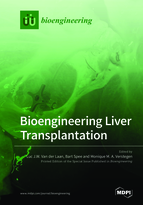Bioengineering Liver Transplantation
A special issue of Bioengineering (ISSN 2306-5354). This special issue belongs to the section "Regenerative Engineering".
Deadline for manuscript submissions: closed (31 May 2019) | Viewed by 63586
Special Issue Editors
Interests: regenerative medicine; liver transplantation; stem cells; tissue engineering; liver organoids
Special Issues, Collections and Topics in MDPI journals
Interests: bioprinting; liver iPSC; organoids; tissue engineering; regenerative medicine
Special Issues, Collections and Topics in MDPI journals
Interests: liver extracellular matrix proteins; recellularization; biomechanical analysis; organoids; bile duct regeneration
Special Issues, Collections and Topics in MDPI journals
Special Issue Information
Dear Colleagues,
The aim of this Special Issue is to review, understand, and evaluate new and exciting opportunities from the field on regenerative medicine, biomaterials, and stem cell research for the bioengineering of human liver grafts that can be applied for transplantation and personalized treatment of end-stage liver disease.
The development of culture conditions for long-term expansion of LGR5+ intestinal stem cells as crypt-villus structures demonstrated the feasibility of deriving complex, organ-like structures in vitro from primary adult tissues, including the liver. Moreover, human pluripotent stem cells (hPSCs) can be applied to generate functionally maturated liver and bile duct epithelial cells.
In this Special Issue, we welcome reviews and original papers focussing on hepatic cell sources, including adult hepatic stem cells, organoids, fetal and induced pluripotent stem cells, and primary cells (i.e., hepatocytes, cholangiocytes, and endothelial cells) and how these cells can be applied in tissue engineering strategies to generate implantable and personalized liver grafts. Potential topics include, but are not limited to, the following: liver tissue engineering, liver regeneration, graft repair, liver stem cells and organoids, bio-scaffolds, and 3D printing.
We invite you to contribute original research papers, as well as comprehensive reviews, aligned with these themes, to advance and improve the actual state-of-the-art in liver bioengineering and providing new opportunities for the imminent medical problem of organ and tissue shortage for transplantation.
Dr. Luc J.W. van der Laan
Dr. Bart Spee
Dr. Monique M. A. Verstegen
Guest Editors
Manuscript Submission Information
Manuscripts should be submitted online at www.mdpi.com by registering and logging in to this website. Once you are registered, click here to go to the submission form. Manuscripts can be submitted until the deadline. All submissions that pass pre-check are peer-reviewed. Accepted papers will be published continuously in the journal (as soon as accepted) and will be listed together on the special issue website. Research articles, review articles as well as short communications are invited. For planned papers, a title and short abstract (about 100 words) can be sent to the Editorial Office for announcement on this website.
Submitted manuscripts should not have been published previously, nor be under consideration for publication elsewhere (except conference proceedings papers). All manuscripts are thoroughly refereed through a single-blind peer-review process. A guide for authors and other relevant information for submission of manuscripts is available on the Instructions for Authors page. Bioengineering is an international peer-reviewed open access monthly journal published by MDPI.
Please visit the Instructions for Authors page before submitting a manuscript. The Article Processing Charge (APC) for publication in this open access journal is 2700 CHF (Swiss Francs). Submitted papers should be well formatted and use good English. Authors may use MDPI's English editing service prior to publication or during author revisions.
Keywords
- Tissue Engineering
- Liver regeneration
- Graft repair
- Liver stem cells & organoids
- Bio scaffolds
- Bio printing









